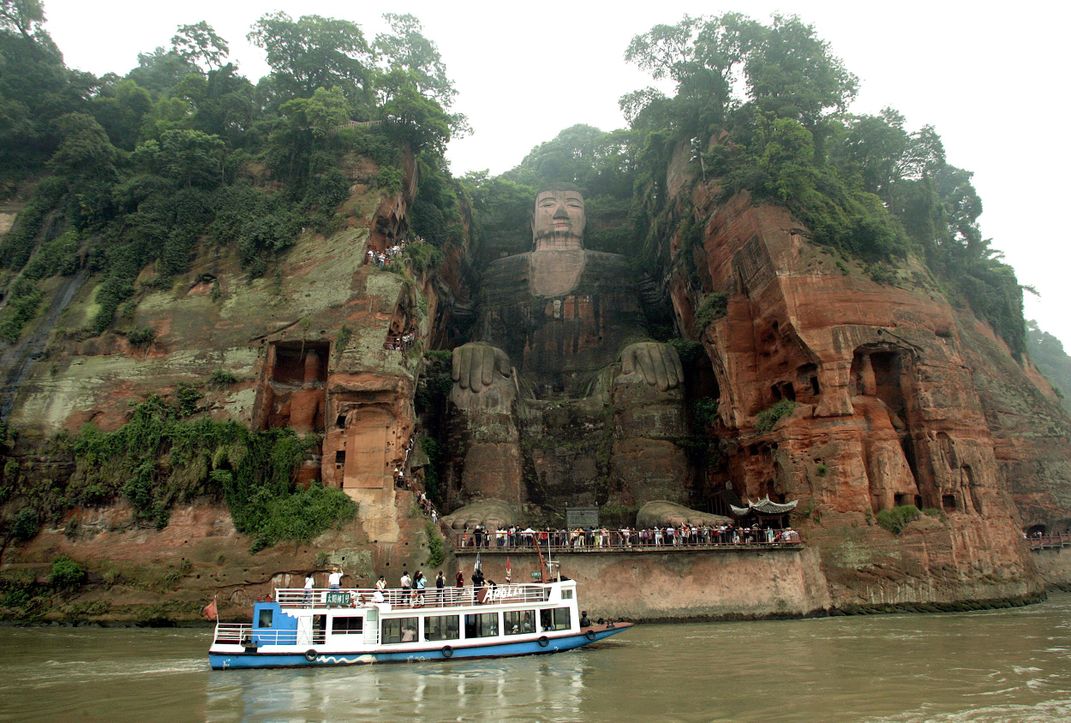Flooding Endangers World’s Largest Buddha Statue
Rising waters in China dampened the toes of the Leshan Giant Buddha for the first time since 1949
:focal(1557x871:1558x872)/https://tf-cmsv2-smithsonianmag-media.s3.amazonaws.com/filer/80/a0/80a01aee-5173-4481-a7e3-c23b2038e18d/gettyimages-1228102358.jpg)
Last week, as massive floods continued to plague southern China, water rose up out of the nearby river banks, lapping at and finally submerging the enormous toes of a giant, 1,300-year-old Buddha statue carved into the nearby cliff. The event marked the first time in at least seven decades that rising water has threatened the statue’s platform.
The Leshan Giant Buddha, an important Buddhist pilgrimage destination that is part of a Unesco World Heritage Site, towers over the water near the confluence of the Minjiang, Qingyi and Dadu Rivers. As water levels rose, officials closed the site to tourists. In an effort to protect the statue, police and staff surrounded it with sandbags—but the water still managed to cover the platform.
Stranded residents in SW China's Sichuan province were evacuated to safety on Tuesday. Sichuan activated the highest level of #flood control response for the first time on record, as rain ravaged parts of the province. pic.twitter.com/0GavAZAXVg
— China Daily (@ChinaDaily) August 19, 2020
This year, the region has seen its worst floods in decades, impacting at least 55 million people. In July, reported Nectar Gan for CNN, the storms displaced more than two million, leaving an additional 141 dead or missing.
“This year’s flooding has unfolded not as a single natural disaster, with an enormous loss of life and property,” writes Steven Lee Meyers for the New York Times, “but rather as a slow, merciless series of smaller ones, whose combined toll has steadily mounted even as official reports have focused on the government’s relief efforts.”
In the Sichuan province, where the Leshan Buddha is located, officials called for the highest level of flood control response for the first time in history, according to state-run news agency Xinhua. In the Yangtze River basin, which accounts for 70 percent of the country’s rice production, flooding damaged people’s homes, farms and food supplies, reports Rob Picheta for CNN.
/https://tf-cmsv2-smithsonianmag-media.s3.amazonaws.com/filer/f4/f9/f4f9a891-2296-42cf-8495-871ad6954cff/gettyimages-122212412.jpg)
The Leshan statue—considered to be the largest stone Buddha in the world—is by far the tallest surviving pre-modern statue. Measuring a towering 233 feet, the colossal artwork depicts Maitreya, a bodhisattva and disciple of Siddhārtha Gautama, the founder of Buddhism. If Maitreya were to stand upright, the Buddha would be nearly eye-to-eye with the Statue of Liberty, writes Bryan Hill for Ancient Origins. The head is 48 feet tall and 33 feet wide; its ears can hold two people inside, and 100 monks are said to be able to sit on one foot simultaneously.
The site is a destination for Buddhist pilgrims. By tradition, Maitreya is considered the “future Buddha,” who will one day descend to Earth to preach new dharma, or law. Worship of the deity was popular between the fourth and seventh centuries.
According to legend, a monk named Hai Tong, who lived during the Tang Dynasty, hoped to build the Leshan statue to appease the river gods and save the lives of people who succumbed to its turbulent waters. For two decades, the monk begged for the funds to begin construction. By the time it was completed (90 years later, in 803 A.D., and several decades after Hai Tong’s death), enough stone was removed from the cliff and deposited into the river that the currents were quelled, "making the waters safe for passing ships," according to Ancient Origins.

Besides the ears, which are made of wood and covered with clay, the statue is carved entirely from the stone face of Mount Emei. Numerous temples and thousands of statues, many dating back to the Tang dynasty, dot the mountainside surrounding the Buddha.
The statue was originally protected by a 13-story wooden pavilion, but the structure was destroyed at the end of the Ming Dynasty. To prevent erosion, the sculpture’s creators constructed a drainage system that drew water away from it. This complex system of hidden gutters and channels keeps the inner parts dry.
Despite precautionary efforts to ensure its preservation, pollution and overtourism threaten the statue, with hundreds of thousands visiting the area annually. In 2001, the Chinese government spent more than $33 million on restoration efforts, according to Reuters. But without a decrease in corrosive rainwater and air pollution, the statue may continue to erode.
The 233-foot Leshan Buddha remains a highlight of any visit to the region. Says one avid traveler: It’s so big, it’ s not easy to see. They add, “Make sure you look at Buddha in four ways: from the top, from sides, from the bottom and from the distance taking an about 15 minutes boat ride.”
/https://tf-cmsv2-smithsonianmag-media.s3.amazonaws.com/accounts/headshot/IMG_1578_copy_copy.jpg)
/https://tf-cmsv2-smithsonianmag-media.s3.amazonaws.com/accounts/headshot/IMG_1578_copy_copy.jpg)